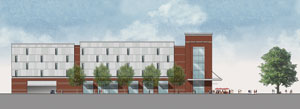 By William C. Shelton
By William C. Shelton
(The opinions and views expressed in the commentaries of The Somerville News belong solely to the authors of those commentaries and do not reflect the views or opinions of The Somerville News, its staff or publishers.)
Much public attention over the past eight months has focused on whether the city should take on $26 million in debt to build infrastructure that would serve Federal Realty Investment Trust’s (FRIT’s) Assembly Square development projects. Over the same period, and almost unnoticed, a consequential development has moved toward approval.
It will produce high net tax revenues, provide visual appeal from critical Assembly Square vantage points, generate few auto trips per day, and help solve critical road configuration challenges. It is a self-storage facility.
Huh? A self-storage facility?

SSG Development’s Assembly Square self-storage facility.
That’s what Mystic View Task Force (MVTF) members thought when approached by SSG Development and Construction representatives in January 2009. The firm had successfully developed a half-dozen storage facilities elsewhere, and it wanted to avoid the kind of conflict that had surrounded FRIT’s strip mall project.
The city’s planning director George Proakis hails the resulting cooperation as “a model of consensus building for development,” such that the project “reached the Planning Board with a positive driven force.” He, his staff, and the city’s Design Review Committee were part of that cooperation as well.
At an April 21st meeting, Planning Board members admired the project’s design and supporting research. Members Favoloro, Moroney, Kyrilo, and Capuano praised the cooperative planning process.
Mr. Proakis quipped that the goal had been to approve the most beautiful self-storage facility in the world. The project may achieve that goal.
And when fully occupied, it should produce about $120,000 per year in annual tax revenues, or about $109,000 per acre, even though a third of it is usable open space. Compare that with the $50,000 per acre produced by the strip mall.
When costs of city services required by the two projects are figured into the calculation, the comparison becomes more striking. For example, the strip mall generates twenty-seven times the number of car trips per day, per acre, that the storage facility will.
These laudable outcomes were not easily achieved. They result from a long cooperative process of identifying problems and crafting solutions.
At their initial meeting with Mystic View in 2009, SSG partner George Bachrach and Attorney Adam Dash presented preliminary plans for the site, which is now a truck depot, across Middlesex Avenue from the end of Foley Street. Mystic Viewers were cordial, but skeptical.
Not much happened for over a year, as Somerville’s city planners studied potential street configurations. In May of last year, Monica Lamboy, head of Strategic Planning and Community Development, got in touch with MVTF. She said that SSG’s project planning would move forward, and she encouraged the two organizations to meet.
At a June 2010 meeting with SSG, Mystic Viewers expressed their concerns. The Assembly Square district is big. The distance between its northernmost and southernmost points is the same as that between North and South Stations.
But it has only three access points: McGrath Highway from the North, Sullivan Square/Lombardi Street from the South, and potentially, an extension of Foley Street under I-93 that would serve East Somerville. The extension would have to cross the project site. And it was important that its design coordinate with pedestrian access improvements that FRIT will be paying for in the near future.
The building’s design would be highly visible to people on I-93, Middlesex Avenue, and locations across the district. Riders exiting the future T station would see it at the opposite end of Foley Street.
Related to this, a prominent industrial facility could harm the district’s perceived identity, discouraging high-value development. And as the rest of Assembly Square were developed, it would be important that the Foley Street entrance not be an unused “dead zone,” discouraging pedestrian activity.
The parties rolled up their sleeves and went to work. Mystic View assembled a highly respected group of local architects and urban designers. They walked the site and spent hours discussing design challenges and brainstorming solutions.
The best west-side entrance to Assembly Square would be a straight-line extension of Foley Street to McGrath Highway. In July, SSG’s engineers, Somerville’s Planning Director George Proakis, Economic Development Director Rob May, and a half-dozen Mystic View members examined the confluence of Foley Street, I-93, and Routes 28 and 38.
They learned that the straight-line configuration was not economically feasible; it would require reconstruction of the I-93 off ramp. The next best alternative would curve Foley Street through the expressway’s supporting pillars.
SSG had planned two buildings for its site. Instead, it offered to build one and give the remaining land to the city for future construction of the Foley Street extension. Moreover, until then SSG would build and maintain a landscaped plaza on the property.
The parties solved the dead-zone problem by incorporating a café, community room, and bike storage into the building, fronting on the plaza.
Storage facilities were not allowed by Assembly Square’s zoning. With Mystic-View input, city staff prepared a zoning amendment that allowed such facilities if they met strict design guidelines, contributed to the Square’s character, and were in near-highway locations that were undesirable for other uses. The Board of Alderman approved the amendment in November.
SSG’s Chief Operating Officer David Fulton, and its architect David Grissino worked for months with Mystic View members led by Lynn McWhood and David Dahlbacka on the building’s exterior appearance. The result was a bold design involving metal cladding with varying textures, a lighted tower visible from all surrounding viewpoints, and illuminated windows that could accommodate art displays. Suggestions from the city’s Design Review Committee refined the design.
FRIT staff were called in for consultation, and they opposed the design’s modernist appearance, concerned that it would not harmonize with the visual branding of their own extensive future developments. City staff concurred.
The resulting compromise adds a more traditional brick base and an all-brick area that will provide what Mr. Proakis describes as a “blank canvas” for graphics. It brings to mind the adage that a camel is a horse designed by a committee. But on balance, it will be a uniquely attractive storage facility and a net plus for Assembly Square.
Easy approval is expected from the Planning Board. One of its conditions will be that the parties continue to work together.















Reader Comments